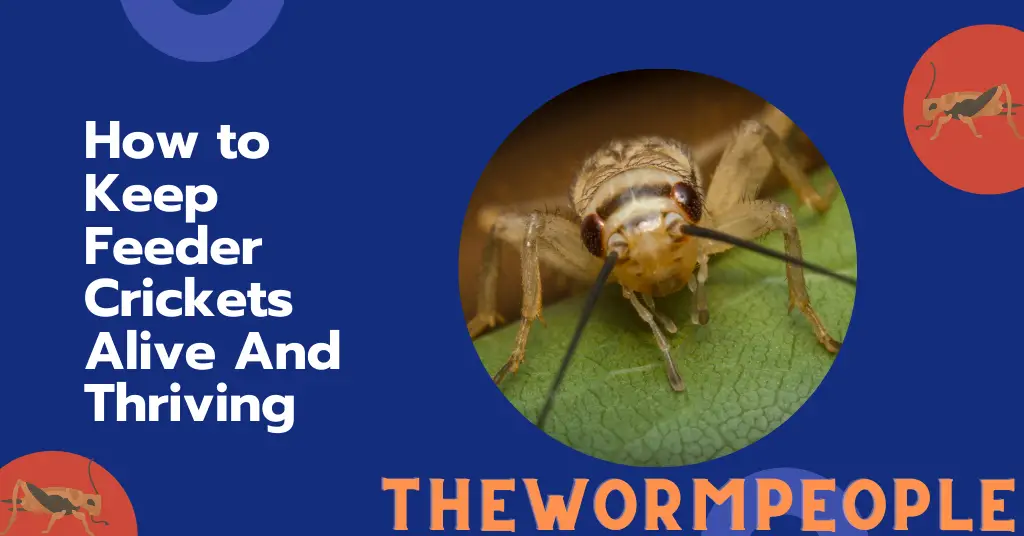
Jeffery Jago is a expert in horticulture and worm breeding. With a background in plant cultivation
Last Updated on July 11, 2021 by Jeffery Jago
Feeder crickets are a great way to provide your pet with an extra boost of protein and calcium. However, it can be difficult to keep them alive long enough for your pet to enjoy their meal if you aren’t a seasoned cricket breeder.
Follow these steps to ensure that your feeder crickets will stay happy and healthy.
How to keep feeder crickets alive? Quick summary
Humidity 50-70%, Don’t expose to direct sunlight. Keep enclosure dry and well ventilated. Add a water sponge and change it every 3 days. Remove frass twice a week. Don’t leave wet food for more than 24 hours. Place wet food on a plate. Keep the temperature at 70-75F.
The more in-depth answer
Even if you aren’t a seasoned breeder and don’t really know what you’re doing, I’m here to tell you that keeping feeder crickets alive and thriving is actually really easy to accomplish and you only need a few things.
First, You should have an enclosure set up. To do this, simply get a larger container with a cover.
It’s important you make proper ventilation in the container. You can do this in 2 ways:
- Cut out square sections of the side and top of the container.
- Stable or glue a fine mesh screen to the outside of the hole you’ve just cut so the crickets can’t escape. Remember, feeder crickets are tiny things and can squeeze out of the most absurdly small holes, so seal it well.
The other method:
- do the same as above, cut out a small square hole, an exist and an intake.
- Add the screen and seal it well.
- Place a very small computer fan on top of the mesh for better airflow.
It’s best to use a cover on your enclosure to prevent the escape of crickets. These guys are pretty good at climbing and escaping.
Consider using baby powder or specially made boundary powder mix on the sides of the container to prevent them from climbing out.
Make sure you use a water sponge and change it every three days. You will need to make adjustments as to how often the water is changed depending on how humid or dry your local environment is, so keep an eye out for that.
The maximum length the sponge should remain in the enclosure is 3 days, after that, it needs to be removed and cleaned.
If you don’t do this, mold and bacteria will begin to grow and put your small colony at risk.
It’s a good idea to add an extra water source so that your crickets have something else to drink as well. Never add a dish of plain water, Instead use water crystals especially formulated for crickets and other feeder insects.
These water crystals dissolve in the cricket’s gut, it provides them with more fluids than they would get from their diet alone.
The other benefit is that because these slowly release into their system, your crickets will be able to stay hydrated for up to two weeks without any risk of drowning.
When placing wet food (fresh vegetables or fruit) in the enclosure, be sure to add it onto its own dish so the liquids don’t leak into the bottom of the enclosure and onto the frass.
This will cause mold!
Mold is also the reason you want to remove any food you’ve place in the enclosure after 24 hours and replace it with fresh fruit and vegetables. This is important, Don’t leave food too long.
As a general rule of thumb, keep the temperature at 70-75F. This will allow your feeder crickets to thrive and stay alive for any length of time you need them to be in their enclosure before feeding it to your pet.
Humidity should also be kept at a high 50-70% for optimal results.
Finally, don’t forget that when cleaning out frass or droppings from inside the container, make sure they’re completely dry before adding new substrate material! You wouldn’t want mold growing now, would you?
Never use wet substrates mixed with water crystals because this will cause mold growth too! Keep an eye out for other insects like fruit flies who might try to take up residence and cause a stink!
Coconut noir is the best substrate to use for your crickets, Just remember to keep everything dry.

